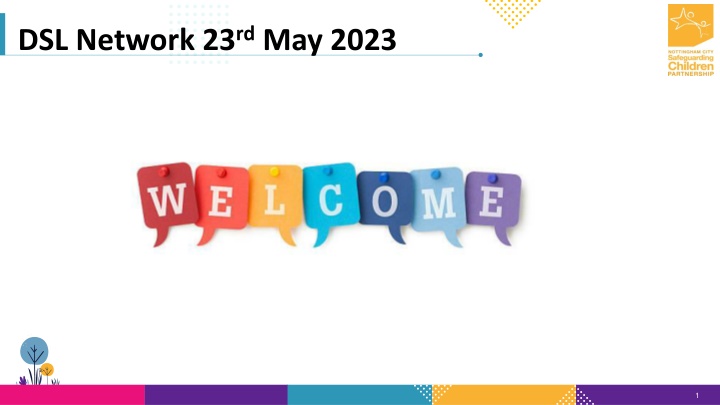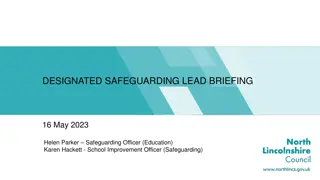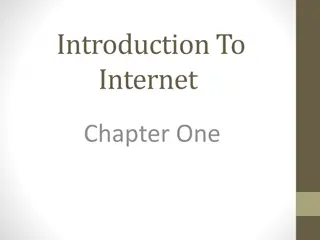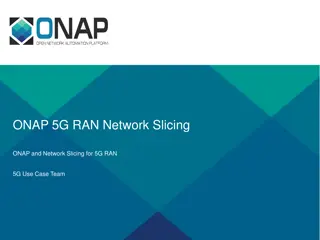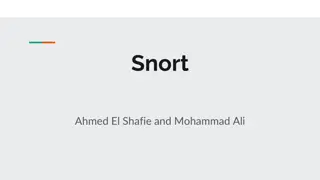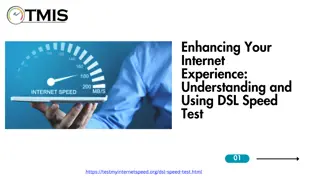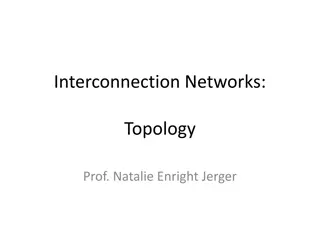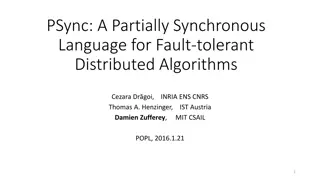DSL Network 23 rd May 2023
The DSL Network event on 23rd May 2023 focuses on the VRP funding that supports interventions for children and young people in Nottingham. The purpose of this funding is to offer leadership in coordinating local responses to serious violence, facilitated by the PCC. Established in 2019/20, the VRP activity includes early interventions, research, data sharing, and ensuring community awareness. The event emphasizes the importance of attending the network sessions and certifying participation for DSL Update training. Home Office funding has been secured for the next three years until 2024/25.
Download Presentation

Please find below an Image/Link to download the presentation.
The content on the website is provided AS IS for your information and personal use only. It may not be sold, licensed, or shared on other websites without obtaining consent from the author.If you encounter any issues during the download, it is possible that the publisher has removed the file from their server.
You are allowed to download the files provided on this website for personal or commercial use, subject to the condition that they are used lawfully. All files are the property of their respective owners.
The content on the website is provided AS IS for your information and personal use only. It may not be sold, licensed, or shared on other websites without obtaining consent from the author.
E N D
Presentation Transcript
Guidance for Participation Please email safeguardingineducation@nottinghamcity.gov.uk if you have not registered already to attend this event Please use the chat for your questions or input and presenters will do their best to answer/address during each agenda item To avoid background noise, please ensure your microphone is muted at all times We would appreciate cameras on at all times for direct engagement All of the presentation slides and resources discussed during the network today will be available on the DSL webpage of the NCSCP website shortly after the network Attendance at a minimum of two DSL networks annually can be certified as evidence of DSL Update training with the expectation that you attend for the full duration of each network and cascade all content to your other DSL/DDSL s (certificates for this will be emailed automatically each summer term) 2
Overview of network content Main agenda item- Serious Violence Duty 09:40-11:50 Built in a short break from 10:30-10:40 Local/National Updates 11:50-12:00 3
Purpose and remit VRP core function is to offer leadership and strategic coordination of the local response to serious violence in Nottingham and Nottinghamshire, facilitated by PCC. VRP Overview VRP activity enabled by the funding must support a multi-agency, public health approach to preventing and tackling serious violence. DSL Network 23rd May 2023 Established in 2019/20 with Home Office Funding to support: Interventions for CYP in City and County 0-25yrs early intervention and prevention Research and evaluation what works to tackle serious violence Data sharing and analysis to inform commissioning System change Ensuring awareness and consensus in Communities Carly McKinney Education Project Support Officer Alison Donaldson Programme Manager Home Office funding secured for further 3 years to 2024/25 5
Purpose and remit VRP core function is to offer leadership and strategic coordination of the local response to serious violence in Nottingham and Nottinghamshire, facilitated by PCC. VRP activity enabled by the funding must support a multi-agency, public health approach to preventing and tackling serious violence. Established in 2019/20 with Home Office Funding to support: Interventions for CYP in City and County 0-25yrs early intervention and prevention Research and evaluation what works to tackle serious violence Data sharing and analysis to inform commissioning System change Ensuring awareness and consensus in Communities Home Office funding secured for further 3 years to 2024/25 6
Public Health Principles Focus on what will make a difference to whole populations Work as a whole system Intervene early to prevent issues emerging Consider the causes of the causes Ensure work is evidence informed 7
VRP Strategic Framework Vision: Our vision is for Nottingham and Nottinghamshire communities to feel safe from violence and the fear of violence Mission: We will work with communities to prevent violence and reduce its harmful impacts through developing a detailed understanding of its causes and investment in evidence based interventions that make a lasting difference Strategic Priorities Make best use of data sharing, insight and evidence Provide inclusive system leadership Deliver and evaluate early intervention and prevention activity 8
Performance Key Success Measures - Home Office Reduction in injury and death due to serious violence Reduced hospital admissions due to serious violence Reduction in first time entrants into the criminal justice system Reduction in 18-25 year olds who are Not in Education Employment or Training (NEET) Reduce overrepresentation of boys from black and mixed ethnicity backgrounds as a proportion of all children cautioned or sentenced. Increased confidence and trust in the police 9
Multi-agency working Multi-agency Board and team: Children s Services Youth Justice Services Public Health Integrated Health Board Education Police Prisons Probation Fire and Rescue Community representation 10
Serious Violence Duty The following authorities will be subject to the duty: Police Local authorities, inc. social care, CSPs Youth Justice Services Probation Fire and Rescue ICB The Serious Violence Duty will be issued under section 19 of the Police, Crime, Sentencing and Courts Act 2022 The Crime and Disorder Act 1998 will also be amended In December 2021, partners agreed that the VRP would lead on the coordination of the implementation of arrangements to meet the Duty under the PCC s convening power Specified authorities will be required to understand local issues through sharing data and information, and formulating an evidence-based analysis of the problems Produce and publish a collaborative strategy Ensure process to review the delivery of that strategy In consultation and collaboration with: Educational institutions Prisons Youth custody 11
Education Data What do we use Education Data for within the SNA? Additional context to the overall violence picture Aspects potentially contributing to youth violence in the area Consideration of additional vulnerabilities, around exclusions and SEN/ECHP Identification of over representation and therefore gaps in activity if further support is needed Education Data ambitions? Links between free meals/deprivation and exclusions Numbers of pupils with SEN who have ADHD Person identifiers for those permanently excluded that could be matched across to other data sets such as health and CJ 12
VRP Education survey Thank you to all who contributed - 67 responses received across City and County Barriers to supporting delivery of violence reduction included: Awareness and knowledge of support Age appropriate content and primary resource Proactive rather than reactive Resources for SEN pupils Services to support perpetrators of HSB Funding Limited availability of resource Parental Consent Gaps in provision identified: Staff awareness/training CAMHS overwhelmed Accessible information for parents Resources for SEND Primary provision Interventions for children living with DV perpetrators Links between CYP and families in prison 13
VRP Interventions VRP commissioned Sports and mentoring - Various Therapeutic Counselling including cognitive behavioural therapy Trauma informed programme supporting CYP who are witness to domestic violence Community outreach Tools Down and CCE programme Street Doctors Detached Youth Work Divert Plus Focussed Deterrence National Justice Museum Nottingham Space 14
National Justice Museum KS2 Upwards Working in Partnership with the Ben Kinsella Trust, Choices and Consequences is proven to encourage positive behaviours and attitudes against carrying knives: Choices and Consequences will teach students: The dangers of carrying a knife. The consequence of carrying and associating with those carrying knives. The law and how it applies to knife crime cases. The realities of prison life. Making positive choices to stay safe. Making safe decisions when it comes to good friends. 15
Nottinghamshire Police PS Kerry Hall Nottinghamshire Police Knife Crime Education in Schools - - - Neighbourhood Policing Teams Mini Police School and Early Intervention Officers (SEIO) Volunteer Police Cadets Early Police Alerts to Schools (EPAS) - - 16
Thank you Any further questions, please contact VRP@Notts.Police.uk 17
School Early Intervention Officers (SEIO s) 19
Nottingham Citys Response to Child Exploitation Claire Wakeman
Nottingham City currently has two toolkits which are used to identify different forms of exploitation that children maybe exposed to. These toolkits are often completed by social workers, they can be completed by partners and agencies to look at risk. In completing the toolkit they are designed to give a rag rating of either Low, Medium or High risk of harm. The toolkits look at : Child Sexual Exploitation and Child Criminal Exploitation.
What is working well ? Social Workers, Partners and agencies are aware of the toolkits and they are being used regularly. But they vary in consistency and consent is an issue. There is a clear pathway for exploitation to be heard at an ERMM (Exploitation Risk Management Meeting) There is a big focus on exploitation, and this means there are external resources for Children/Young People, funded by the Violence Reduction Partnership. Toolkits are reviewed weekly with advice to workers and managers about what services are best to support the child/young person
What we have identified is not working well There is currently a lack of analysis in the toolkits which are being received. The current toolkits do not allow the child to move away from the past harm. Professionals often score high on the toolkits with little evidence for the decision and therefore the thresholds are not consistence. There is a lack of acknowledgement from professionals that children can move through different forms of exploitation. Partners who attend the ERMM s are often not in a position to take on the recommendations made and this is especially is relevant in respect of the police where disruption is required or CAWN s need to be considered.
What we have done The CSE and CCE toolkits have been combined into one resource and we will propose they are called a Risk Assessment , there will be space to allow practitioners to provide an analysis and evidence the risk of exploitation for the Child/Young person. In having a Risk Assessment this will bring Nottingham City Council in line with our partner agencies. Radicalisation has been incorporated into the exploitation risk assessment, which means for the first time we have a recording facility for radicalisation when considering exploitation on Liquid Logic. The policy and procedures for Exploitation has been reviewed and provides clear direction of processes and timing s for the review of ERMM s. The Risk Assessment has been built on Liquid Logic and a pathway for exploitation is being created, this will also provide data reporting on exploitation which will be in real time. The Terms of Reference for Mase have been reviewed and the expectation of partner agencies who attend.
What we still need to do As part of the learning offer appropriate language when discussing exploitation needs to be reinforced to ensure there is no victim blaming. The word child rather than young person needs to be used to promote the rights that children have as a victim. Learning and development needs to be offered to all staff around the new Risk Assessment, what the signs of exploitation are and how to support Child/Young people who are risk of exploitation. A learning offer also needs to extend to partners. A directory of resources available to Children who are at risk of Exploitation in Nottingham City to be put together to assist professionals. Terms of reference for ERMM s will be formed and will include the expectations of professionals attending exploitation meetings
Mase (social workers will attend and provide brief update) and Neighbourhood Safeguarding Disruption (NSD) lead by the police and will focus on disruption. Exploitation pathway ERMM- will be held as soon as possible and devise a safety plan around the child and consider if an NRM National Referral Mechanism is required. Risk Assessment will be completed and reviewed, this will be on a weekly basis
An introduction to Nottingham City Youth Justice Service (YJS) Thomas Cullen, Operations Manager Performance and Development 28
A bit of history: YOTs have been in place since 2000 Formed by Crime and Disorder Act 1998 Governed by the Youth Justice Board + National Standards Increased co-ordination between YOTs and Children s Services brought about by the Children Act 2004 Working Together Nottingham City Youth Offending Team replaced by Youth Justice Service: Within the Early Help directorate, alongside Children s Centres, Youth Services, Supporting Families and CAMHS. 29
Governance Comprehensive, three year Youth Justice Plan is refreshed and reviewed annually. Governed by YJ Management Board Chaired by Corporate Director and includes senior representation and engagement from statutory and wider partnerships, including education, health, Police, Children s Services, Probation, VRP. Nottingham City YJS follows the four tenets of the Child First principles: to see children as children, develop pro-social identity for positive child outcomes, collaboration with children and to promote diversion. 30
Who works at the YJS? Case Managers oversee a caseload of children who are subject to out of court disposals and court orders EVR Hub/Targeted Youth Support (TYS) workers work with children that have been identified as at risk of SYV/CCE Reparation workers undertake reparation sessions with children as part of their court orders Nurses see most children who come to the YJS Police see some children and give Out of Court Disposals to children. Probation there is one seconded Probation Officer who works as a Case Manager and a second part-time PSO both support Y2A transitions Managers oversee case managers who are split into various teams Business Support Team (BST) who carry out the administrative functions, including arranging Referral Order panels and court paperwork Junior Attendance Centre (AC) staff which runs on a Saturday and offers offence focussed programmes and reparation Community Panel Volunteers 31
Operational Partnerships Futures Advice & Guidance and continued focus on developing ETE options Nottm Works 4 You, Skill Mill, accredited programmes (AQAs) at the JAC etc. Strategic, multi-agency focus on cross-cutting issues (e.g. exclusions, SEND, safeguarding). CAMHS (Head2Head) resource co-located with YJS. LD Nurse co-located to support YJS cohort with SEND. Dedicated Analysis & Insight resources available to the support the YJS and partners - view through matching of data across systems re: risk, vulnerability, offending profiles and demographics. Wider partnership with commissioned services (e.g. Victim Care, CGL, Passages, Appropriate Adult Service, Base51) to ensure a comprehensive, relevant and tailored service offer to meet the needs of YJS cohort. 32
Who is seen by the YJS? Children become criminally responsible at the age of 10 years old and can be given out of court disposals and court orders. Children may also be seen before the age of 10 by the preventative services, if a risk of offending is identified. Our office is at NGYmyplace, 29-31 Castle Gate where some children are seen. Children are also seen at home, and in community settings. If in custody, or out of area, regular welfare visits are undertaken. 33
Key points of entry into YJS Preventative - Targeted Youth Support, Turnaround and Another Way Pre-Court: Bail, remand and Pre-Sentence Report (PSR) Out of Court Disposals: Community Resolution, Outcome 22, Youth Caution, Youth Conditional Caution Post Court Referral Order, Youth Rehabilitation Order, Detention and Training Order, Custody 34
Targeted Youth Support Proactive early intervention approach to prevention for those children at risk of youth/weapon-enabled violence Early interventions to reduce anti-social behaviour in the community Partnership work including with groups of children in school and community settings Build professional capacity for more effective outcomes including staff consultation 1:1 support to address behaviour, build confidence and esteem in children through planned interventions 36
Out of Court Disposal Panel Case referred by Police is screened for eligibility and allocated for assessment OoCD panel meets every Tuesday, considers each child s assessment and comes to a decision on outcome. Panel consists of representatives from a range of partners including: YJS Management Social care Management YJS Police Education Welfare services - Management CAMHS - Clinical Nurse Specialists CGL - Drug and Alcohol service Early Help services 37
Out of Court disposals Following comprehensive assessment, disposals and interventions will be agreed by all panel members and the child will then receive one of the following: Outcome 20 This is given if there are professionals or support already in place which doesn t require any additional work by YJS Outcome 22- A number of different professionals or support is in place but requires some additional intervention either by YJS or other agencies. Community Resolution With a minimum intervention provided by YJS Youth Caution issued by YJS police to the child and any interventions completed by YJS Case Manager. Youth Conditional Caution issued by YJS Police and package of intervention delivered by YJS staff, including partners. 38
Knife crime 1. Child is arrested and taken into Police custody and interviewed 2. 3. YJS notified (May be delegated to Duty Manager / EDT) Screening assessment completed and Knife Crime Decision Record (KCDR) completed decision made to either (1) issue YCC or (2) bail for full assessment. Decision relayed to Police Custody staff 4. 5. Child is either: (1) issued with YCC with condition to engage with YJS assessment and intervention, or (2) bailed with conditions to engage with YJS assessment process. 39
Case example 1 Child, 14 years of age, seen collecting item from bush outside care home by residential staff Care staff have been worried about child s behaviour over the last three weeks, with him being more withdrawn and secretive Has disclosed to his keyworker that he owes some money for cannabis and has been threatened by undisclosed dealers Child has an EHCP and has active input from CAMHS support alongside medication for ADHD Three recent missing episodes, the full details of these have not come to light 40
Case example 2 13 year old boy found in possession of a Stanley knife at school Knife seen and reported to Police by staff who had seen it in his bag at the end of the day Child admits he had taken it from his Dad s toolbox a couple of weeks ago and had it in his bag as he was scared and being bullied at school Said he was very sorry, had no intention of using it and had never removed it from his bag which he kept in his locker No previous offence history 41
Court-led YJS Service Community Orders: Referral Order Youth Rehabilitation Order (YRO) Custodial sentences: DTO/Custody Bail Remand to Youth Detention/Local Authority 42
Complex children Multiple needs, high-risk behaviours & complex management difficulties High risk, high harm, high safety and wellbeing concerns Common histories complex experiences of trauma including: Adverse Childhood Experiences (ACES); Attachment Parental substance misuse / mental health / domestic abuse Speech & Language Communication Needs (SLCN) Special Educational Needs & Disabilities (SEND) 43
Contact us For enquiries about a specific child: Duty officer/Business support on 0115 9159400 or email YJS@Nottinghamcity.gov.uk For enquiries about a child in relation to child criminal exploitation: Contact Ged Mayer via 0115 9159400 or email Ged.Mayer@nottinghamcity.gov.uk To enquire about, or make a referral to the TYS Prevention service, email EVRHub@nottinghamcity.gov.uk To contact me, call 07432 721245 or email Thomas.Cullen@nottinghamcity.gov.uk 44
Trauma Aware Approaches in Education Louise McDonagh, MHST Manager 45
Trauma Aware Approaches in Education Who we are: Mental Health Support Team 1. One to one support for children 2. Sign-posting for additional support 3. Whole School Approaches 46
What do we mean by trauma? Trauma is not the event, it is our reaction to it... this is why one person can respond very differently to the same experience- think of children living in a house with DV- one may still flourish in school, another may be really struggling. It is a dysregulated nervous system as part of our stress response. Our nervous system s response to events that surpass its ability (or inability) to cope. Consider universal precautions in the medical world- treat everyone we meet as if they are living with the impacts of trauma. 47
What do we know about trauma? New research into affect of trauma on cognitive abilities as well as affective e.g. ability to read emotions Downstairs- breathing, heartbeat, temperature- emotions (limbic)- fully furnished and decorated Upstairs- cerebral cortex- executive function, reasoning, language- under construction Where in the brain, is this child? Greene (2008) some challenging behaviour stems from expectations exceeding the cognitive skills they don t or can t access at the moment. When we have been exposed to prolonged trauma we are in a constant state of stress- the nervous system is in a heightened level of awareness for longer- chronic dysregulation can occur- we spend more time downstairs than upstairs. TOXIC STRESS: affects brain development- especially attention, decision making, learning and response to stress 48
The impact of developmental trauma Development is DYNAMIC. Developmental tasks build on themselves, with success and mastery at a given stage laying the foundation for potential success at later stages e.g. the child who has had successful relationships with primary caregivers in early childhood will be learning the skills of reading verbal and non-verbal cues, turn-taking, delayed gratification and tolerating/negotiating conflict. Our brains have neural plasticity- it changes and adapts in response to experience- development of the brain is use-dependent. There are two ways through which complex developmental trauma can be conceptualised as having its impact: 1. The prioritisation of certain developmental tasks and skills- typically those relevant to the child s survival 2. The interference with other developmental tasks- frequently those most dependent on the availability of safe attachment and safe context. 49
What does your behaviour policy look like? Punishments as consequences For some students the sanction acts as a large stone being dropped into a small pond- the ripples are felt all day. Does the sanction teach about better choices? Does it teach about emotions and regulating them? Does it improve social skills? Does it teach about healthy relationships? Does it improve wellbeing? The reality: They can act as an effective deterrent for the majority- most of us probably fell into that camp in school. For a significant minority they have no benefit . These students will either brazen it out, avoid the sanction and be damned to the consequences, or escalate. Most justice systems are borne from our urge for retribution; driven from our threat response. We want retribution for perceived affronts to our authority and dignity Lykken, 1957, there are significant numbers of people for whom the effect of punishment on behavioural choices is low; reward, or the anticipation of reward, is an effective way of influencing behavioural choices. 50
